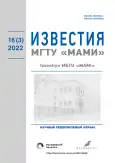The spark plug’s thermal state simulation
- Authors: Yakhutl D.R.1, Maleev R.A.2, Zuev S.M.2, Shmatkov Y.M.2, Ryabykh E.A.2
-
Affiliations:
- Scientific Research and Experimental Institute of Vehicle Electronics and Electric Equipment
- Moscow Polytechnic University
- Issue: Vol 16, No 3 (2022)
- Pages: 273-280
- Section: Electrotechnical facilities and systems
- URL: https://journals.rcsi.science/2074-0530/article/view/126634
- DOI: https://doi.org/10.17816/2074-0530-110852
- ID: 126634
Cite item
Full Text
Abstract
BACKGROUND: Spark plugs are among the most important components of the ignition system of an internal combustion engine (ICE). The spark-over produced by the ignition system should have sufficient energy for combustion initiation at any engine operation mode in all the service conditions. Start properties, reliability, power, fuel efficiency and exhaust toxicity of an ICE essentially depend on excellence of design and manufacturing quality of a spark plug. On the other hand, functional properties of spark plugs depend on concordance to ICE with main dimensions, design, heat properties and value of a spark gap. AIMS: Use of the methods of the spark plug’s temperature field simulation in order to reduce the amount of experimental studies and to reduce the number of specimen options subjected to laboratory and on-road engine tests.
METHODS: The simulation model of the temperature field of a spark plug of an internal combustion engine (ICE) was developed in this study.
RESULTS: The representation of temperature distribution in the insulator’s thermal cone and other ceramic elements of a spark plug was obtained. The dependence of thermal conductivity and specific thermal capacity of corundum ceramics on temperature was derived. The dependencies of thermal conductivity coefficient of the plug’s ceramic insulator are presented. The analysis of thermophysical properties of the substances made of various materials was carried out. The equations of the temperature field of all parts of a spark plug (a contact head, glass sealant, an insulator, a central electrode, a spark plug’s body, a heat-sinking washer, a sealing ring, a cylinder head) were developed. The schematic representation of the spark plug geometry, used in the temperature field calculation, was obtained. The requirements for boundary conditions for calculation of the temperature field of a spark plug were determined. The calculation scheme of the spark plug is presented. The condition of heat exchange at the boundary between the selected part of a cylinder head and the cooling system of an internal combustion engine was considered. The study of heat transfer between the structural elements of a spark plug and the air inside the ICE compartment was carried out. The dependencies describing the heat exchange between the structural elements of a spark plug being in thermal contact with each other were determined and the internal boundary conditions were established.
CONCLUSIONS: The presented methods and algorithms of spark plug’s thermal state simulation helped to perform the calculation of dependencies of thermal conductivity and specific thermal capacity of the insulator’s ceramics as well as the thermal conductivity coefficient of the plug’s ceramic elements on temperature.
Full Text
##article.viewOnOriginalSite##About the authors
Daut R. Yakhutl
Scientific Research and Experimental Institute of Vehicle Electronics and Electric Equipment
Email: niiae2@yandex.ru
ORCID iD: 0000-0001-6650-1180
SPIN-code: 6567-0332
Cand. Sci. (Tech.), Deputy Director of the Institute
Russian Federation, 38 Bolshaya Semenovskaya street, 107023, MoscowRuslan A. Maleev
Moscow Polytechnic University
Email: 19rusmal@gmail.com
ORCID iD: 0000-0003-3430-6406
SPIN-code: 7801-3294
Associate Professor, Cand. Sci. (Tech.), Professor of the Electrical Equipment and Industrial Electronics Department
Russian Federation, 38 Bolshaya Semenovskaya street, 107023, MoscowSergey M. Zuev
Moscow Polytechnic University
Email: sergei_zuev@mail.ru
ORCID iD: 0000-0001-7033-1882
SPIN-code: 6602-6618
Associate Professor, Cand. Sci. (Physics and Mathematics), Head of the Electrical Equipment and Industrial Electronics Department
Russian Federation, 38 Bolshaya Semenovskaya street, 107023, MoscowYuri M. Shmatkov
Moscow Polytechnic University
Email: yuru.schmatkov@yandex.ru
SPIN-code: 8107-6692
Senior Lecturer of the Electrical Equipment and Industrial Electronics Department
Russian Federation, 38 Bolshaya Semenovskaya street, 107023, MoscowEvgeniy A. Ryabykh
Moscow Polytechnic University
Author for correspondence.
Email: fczl98@bk.ru
ORCID iD: 0000-0001-7112-1019
SPIN-code: 4843-6000
postgraduate student of the Electrical Equipment and Industrial Electronics Department
Russian Federation, 38 Bolshaya Semenovskaya street, 107023, MoscowReferences
- Yakhutl DR, Bass BA, Maleev RA, et al. Spark spark plugs. Design and Manufacturing Fundamentals: Tutorial. Moscow: MGTU «MAMI»; 2010. (in Russ).
- Maleev RA, Zuev SM, Fironov AM, et al. The starting processes of a car engine using capacitive energy storages. Periodico Tche Quimica. 2019;16(33):877–888.
- Skvortsov AA, Khortov VP, Zuev SM. High-voltage starting systems of combustion engines. Int. J. Pure Appl. Math. 2016;111(3):455–465. doi: 10.12732/ijpam.v111i3.9
- Breden D, Karpatne A, Suzuki K, et al. 2.1. High-fidelity numerical modeling of spark plug erosion. In: Ignition Systems for Gasoline Engines: Internationale Tagung Zündsysteme für Ottomotoren. 4th Int. Conf. Dec. 6–7, 2018, Berlin, Germany. Tübingen: Expert-Verlag GmbH; 2018:55–74.
- Wolk B, DeFilippo A, Chen J-Y, et al. Basic explorations of limits of microwave assisted spark plug in constant volume combustion chamber. In: Fall Technical Meeting of the Western States Section of the Combustion Institute 2011 (WSS/CI 2011 Fall Meeting) Riverside, California, USA 17–18 October 2011. New York: Curran Associates; 2011:590–602.
- Zheng D. The advantages of non-thermal plasma for detonation initiation compared with spark plug. Plasma Science and Technology. 2016;18(2):162–167. doi: 10.1088/1009-0630/18/2/11
- Crispim LWS, Hallak PH, Benilov MS, et al. Modelling spark plug discharge in dry air. Combustion and Flame. 2018;198:81–88. doi: 10.1016/j.combustflame.2018.09.007
- Bellenoue M, Labuda S, Ruttun B, et al. Spark plug and corona abilities to ignite stoichiometric and lean methane/air mixtures. Combustion Science and Technology. 2007;179(3):477–496. doi: 10.1080/00102200600637584
- Oliveira C, Souza-Corrêa JA, Amorim J, et al. Optical and electrical diagnostics of a spark-plug discharge in air. Journal of Physics. D: Applied Physics. 2012;45(25):255201. doi: 10.1088/0022-3727/45/25/255201
- Kawahara N., Tomita E., Takemoto S., et al. Fuel concentration measurement of premixed mixture using spark-induced breakdown spectroscopy. Spectrochimica Acta Part B: Atomic Spectroscopy. 2009;64(10):1085–1092. doi: 10.1016/j.sab.2009.07.016
- Yang C, Wu X, Ma H, et al. Experimental research on initiation characteristics of a rotating detonation engine. Experimental Thermal and Fluid Science. 2016;71:154–163. doi: 10.1016/j.expthermflusci.2015.10.019
Supplementary files










